Nothing can replace the pleasure of sailing when it is shared within the family circle. Yet changing your life to go and live on the water is not at all easy. With a few rare exceptions, it is the men who lead the women onto the boat. Not always, however, and aboard Kangaroo, the first Fusion 40 assembled in France, it was Muriel who started to sail on Lake Geneva, when her husband, Hervé had never set foot on a boat. She was able to pass on her passion, and in no half measures: Mini Transat, Figaro, and regattas on an M2 (the competitor to the D35) on Lake Geneva. They are both cruising in the West Indies at the moment with their children. Annabel, who, with Fabien and their four children, left aboard Tahoma, wrote “why would we leave a life with which we were so happy? We hadn’t counted on Fabien’s obstinacy; patiently, he showed us how this voyage would be constructive.” Before continuing “We approached turning forty by exercising our freedom. Over and above the openings and richness that our encounters with the local civilisations and populations brought to the children, that is also what we want to pass on to them. That they know that they can decide to orientate their respective lives as they wish, despite all the constraints that they will be faced with. That with audacity and tenacity, we can choose to be free.” And Fabien added: “For about ten years now, I have been dreaming of this voyage. I have orientated a large part of my life, including my professional life, towards this aim.”
When the decision has been taken to go and discover the world aboard a sailing boat, you have to manage a daily life which is not the same as the one you have been living ashore. Though you wouldn’t think so, during the week, a couple finally spend very few hours together. The working day is 8 hours long, and if lunchtimes (rarely spent together) and time spent travelling are added to this, you very quickly end up with 10 hours. Take off 8 hours’ sleep, and there remain 6 hours, and this on condition that you both have timetables which coincide. In actual fact, it is more like 4 or 5 hours. If you take off the hours during which each of you go about your own business, you arrive finally at very little time, which is not always pure pleasure when fatigue and stress are involved. Would things be radically different aboard a boat? Do we have to deduce from this that all that remains for us to do is to go and live on fresh air through the simple fact of having extricated ourselves from daily or professional life? That is perhaps rushing things, and it is never that simple. The fatigue associated with work has certainly disappeared, but there is that of the voyage. The stress of the city has gone, but it has been replaced by that of standing your watches, of life in harbour, of the boat, its maintenance and the navigation. And above all, there is the crowded accommodation. Couples who reach retirement age and who do not know what it is like to live together 24 hours/24 sometimes need an adaptation period, which can often last for several months and sometimes more. Aboard a boat, things can be exactly the same.
Although life ashore allows some escape mechanisms, at sea, and even at anchor, it is more difficult, even if you end up by reproducing the same plans you used ashore; sporting friends or parents of other children become ‘cruising friends’. For the woman, it becomes complicated to go and see, or telephone, her best friend, and for the man, to spend an evening with friends. Of course there always remains the possibility of isolating yourself in your cabin. In reality, it is best to burst the abscess before it becomes infected, so as not to have any animosity towards the other person. At sea, the rhythm of watches is tiring, which exacerbates irritability and sometimes makes you less than intelligent. “When we arrived in the Azores once,” the author recalls, “after a two-week passage, we argued stupidly about whether a spring or a head rope had not been rigged where the other would like to have seen it.” Other arguments can concern the choice of the exact place to anchor. “A lot of long-term voyages stop in the West Indies, as the couples don’t get on any longer,” Pascale and Patrick, from La Casa Delmarre, wrote in their blog, “and when we bring up the question during discussions during an evening spent on other boats, we realise that this is a major preoccupation, often a taboo, for a large number of boats who are sailing as a couple or a family. And everyone agrees about what is responsible: overcrowding, always overcrowding...”
One of the reasons for differences stems from the aims. It is important to define them clearly...and jointly. There is nothing worse than a boat aboard which one person wants to go north, the other south. But living together all the time seems like paradise for those who love each other, even if it is no longer as good as they would like, and they already miss the early days, as Brassens sang, “the lovers who exchange kisses on the public benches (...) who have already experienced the best part of their love.” Life at anchor is a good time for siestas and lie-ins, there is nothing to stop them going further (it is even recommended!), and these private moments (which ashore are often limited to weekends) are there to cement the couple...and help it (with the assistance of a little complicity) face up to difficulties linked to overcrowding in their shared life.
The logical continuation of things in the story of a couple who love each other is the arrival of children. What is the best time to leave? What is the best period of their lives for the voyage to be on the one hand most beneficial for the children and on the other not to penalise their schooling?
In adolescence, departures may prove to be less easy, as girlfriends and boyfriends play a more significant part in the youngsters’ lives and spending all their time with their parents is not their first priority. Hugo, from Tahoma, was 18 when they left; his voyage was to last just one year. He wrote: “Sailing is one of my favourite activities, even though I find piloting a ‘ship’ like Tahoma (a fast, 53m catamaran, all the same) is not exciting at all... I prefer hanging onto a mainsheet with my teeth and trapezing in a strong wind in the Golfe du Morbihan. Otherwise, I get on very well with all my family, even though there are a few undeniable tensions, which I hope will disappear when the pressure of schooling is lifted.” His sister Sybil, 15 years old when they left, was more divided: “Of course it’s a wonderful experience, but I am at an age where I prefer spending time with your friends, going out or staying at home quietly, rather than setting off for an adventure.” As for Mahut, even younger, and apart from the fact that she was leaving to “see turtles and sea lions in the Galapagos Islands, dolphins in the ocean and the white sand of Tahiti,” her mother clarified that she “had forgotten to say that she is passionate about sailing and that she has not been out of her blouse and docksiders for several months and that she refuses to go to the seaside unless she can go sailing. In short, she follows her father like his shadow and remains fixed to the watchkeeper’s seat, even in bad weather.” For Siegrid, the youngest, aged 7, nicknamed Sissi, it’s simple: “I am happy to be leaving aboard a boat, because I will be on the sea with the dolphins,” even though “at the same time I am sad, as I am leaving all my friends.”
As far as school is concerned, French-speakers are privileged, as they benefit from a distance learning structure, the CNED. Education is not to be taken lightly. It demands an investment which will occupy half the day for the crew, a time which increases proportionally with the age of the children until they become independent, generally when they enter the secondary phase of their education. In reality, it seems that it is more often than not the mothers who let the primary school teacher in them express itself and give their time unstintingly to the lessons, whilst the father cleans and maintains the boat (far be it from me to want to generalise...). With a child of school age, it’s a lot of work. With two, it’s even more, especially when they grow up: “much more than during our previous voyage,” Pascale and Pascal from Imagine admit: “the children have grown up, they are in the 4th year and CM1, and there are more subjects to study. They therefore spend more time (and so do we) than they did, and the school timetables are almost the same as ashore.” However, as the years pass, the observations change: “The following year Romain and Bastien had become completely independent, like real little university students. What a pleasure it was for the parents to wake up and find the children already working, so they could get their maths done before breakfast!”
And then? Children who have been cut off for too long from the traditional school environment may sometimes have difficulties returning to it; others, on the contrary, monopolise the first places. Two years after their return, Fabien from Tahoma was a happy father: “Their reintegration went well: Hugo has just started his second year studying graphic art, Sybille passed her Bac with distinction, and is preparing to go to a school of commerce. As for the two little ones, they are at the top of their classes.” The biggest difficulty seems to come from the constraints. “A few weeks after they returned to school,” Joëlle from Mateo wrote in her blog, “Sylvain’s geography teacher told us that at first he seemed like a Martian in the class. As for Florian, his first school results showed that he couldn’t follow the French 3rd year, and that it was better for him to relearn the basics in the 4th. He was moreover much more comfortable with the youngsters in that class, than with his old friends from before our departure, who had developed differently and with whom he felt lost. The second year went much more easily, they have got used to it.”
On a voyage lasting several years, such as a circumnavigation, it can thus be beneficial for everyone to stop somewhere (and not necessarily in a French-speaking country), to spend a school year, whether in Columbia, the United States, Tahiti, New Caledonia, or elsewhere. A long stopover will also allow you to earn some money, or, why not, carry out some major work on the boat, rent a flat or a house... This is what Romain and Bastien, from Imagine, did in Raïatea: “The children are at school, and they love it; after 4 weeks at school the reports are excellent,” their mother wrote. “They have returned with pleasure to the teachers, their friends, the evening homework, and there are also lots of good marks. Let’s hope it lasts! Yet the rhythm is much harder than with the CNED: getting up at 6am, school bus... At midday, the food at school is good, so why go without?”
There is nothing better than total immersion for learning a language, at an age when they learn easily (read 'Rouge Brésil' by JC Rufin). This knowledge of languages is good, and can open the door to many encounters, such as this tale which happened to Bastien from Imagine: “We went to Sète to a Cesaria Evora concert. As I know her music, and the words, (even in Portuguese), I went down to the front of the stage with some other people who were dancing. At one moment, Cesaria, amazed that I knew the words of her song, asked me to dance, and I went! Then at the end, before she sang her encore, I said to her: Puede cantar ‘Nho antone escaderode’ ? It’s my favourite song! She seemed surprised, and said nothing in reply. She sang her encore, then said something to her musicians, who nodded ‘yes’. Then the pianist played a few notes, and Cesaria sang ‘Nho antone escaderode’ It was brilliant!” For the parents, learning a language will always be a bit more complicated.
Family life on a boat is a rare and unique moment to be shared, which will mould the children for their whole life. Remember that Karine Fauconnier, or the Bourgnon brothers, Yvan and Laurent grew up on a boat. In the Marquesas, they attended the local primary school and legend has it that they went there on a windsurfer...
At the end of the first year of their voyage, Joëlle and Dominique, from Mateo (a Jasmin 39, designed by Jacques Fioleau, that they built themselves) took stock for the first time. “The first observation is that there are still 4 of us aboard! It’s not always easy to live 24h/24 as a family on a boat. We are discovering each other in a different light, even though we have been living together for nearly 20 years, and we are also developing differently. Here we cannot escape and go and discuss with colleagues and friends... So sometimes things become quite stormy! And even though the children and the parents each have their own hull, there is still the overcrowding, with its advantages and disadvantages. We see our children developing more closely, but their squabbles also affect us more. There are even some moments when we ask ourselves what we are doing here, why we have dragged our children into this adventure and if it would not be better to go home immediately.” A year later, the voyage seems to have reached ‘cruising speed’: “our existential questions from the end of the first year have occupied our minds less. As we had accepted the decision to cross Panama, we experienced some moments of great happiness. Giving ourselves a break and travelling as a family is nowadays an exceptional luxury. Caught up in the rhythm of work, studies and activities, everyone lives their life in their own corner and without realising it, we reach the moment when the children leave the family nest.” Because it is certainly not as easy as all that to live constantly with your children in a very limited space, such as aboard a boat, even if it is a catamaran. “It has however given us a closeness, a complicity and a real family life that we would never have tasted by remaining ashore,” Joëlle continued. And that is priceless, when we compare it to the moroseness, the pessimism and the individualism we find when we return.” Mateo is in New Caledonia, and its crew returns to it from time to time for (too) short cruises, whilst waiting to leave again for a longer period. After the return, Charly, who aboard Ushuaia (with Isabelle and their 3 children, Bastien and Thibaud, 16 and Laura, 13) reached Australia from Quebec wrote: “For us, this voyage has been a means of getting to know each other better, and experiencing an everyday adventure together. We left with three teenagers, two of whom passed their Bac in Tahiti; this has allowed us to find each other and unite before each of us takes his or her own route, particularly for Bastien and Thibaud, who have since taken off for other horizons. This has allowed us to become closer to one another, so we can then accept being separated more easily: taking flight towards adulthood.
“What is important is the path,” wrote Pascal from Imagine. “The path is a different family life, all together, all of the time. It is not as easy as ashore, not as comfortable, not as simple, never predictable, you cannot rest on the others. But the path is also an incomparable feeling of freedom, a density of intense moments, a succession of discoveries, of landscapes, of people, of countries, an intimate contact with nature and space, a rich life.” The children will always be a link between the crews. La Casa and Imagine followed each other for a certain time, one of them delayed a departure, the other modified their programme a little, to continue enjoying this friendship. Other links were created, as for example when Imagine met Aupaluk, with Natalie, Franck and their two children Claire, 11 and Yann, 10, and Ushuaia. The children from these two boats had moreover heard about Imagine from Téou, the Looping 16 well-known at Multihulls World, (the sailing world is very small...). These friendships also allow the parents to escape for an evening; it isn’t always easy to find a babysitter so the adults can go out together. At Cape Verde, Imagine and La Casa Delmarre left their six children (four on one boat and two on the other) aboard La Casa Delmarre, with strict instructions, and under the supervision of José and Paul, recruited to avoid theft, who, from being guardians, were promoted to baby sitters! “They carried out discrete supervision on the water,” Pascal recounted, amused, “and went to see the children on the boat once an hour to check that everything was all right.” The children also avoid certain problems, as the architect Patrick Luscher underlined a few months ago, whilst moored in Brazil: “Singlehanded sailors are the prime target for louts at the exit from the marinas in the big towns: five aggressions with knives, broken bottles or revolvers in three months at Salvador/Itaparica, by day and night. Couples are less involved and if there are children present, there is no risk at all (we even envisaged renting out babies so people could go out at night!).” At the end of one year, Nathalie and Franck, aboard Aupaluk 2, a Lagoon 42, (just like Ushuaia, with whom they had sailed as far as New Caledonia) drew up the first evaluation of their voyage: “This wind of freedom has brought us closer to nature, to each other and to others. We are still enjoying it, and the fact that we left as two families has given the voyage even more flavour. The children want more, even though school aboard the boat is not always easy.” During their first trip, the crew of Imagine had the impression that they were returning after the Sunday outing. “The people haven’t changed,” they wrote then, “except for the children.” But as luck would have it, a few months later, they set off again for the islands of the Pacific...
To continue the voyage...
We prepared this dossier by working with the sailors’ blogs. Tahoma (http://www.tahoma.fr/pages/reverpag.html), a superb, professionally-built boat, in plywood-epoxy, is for sale. La Casa Delmarre (http://www.lacasadelmarre.com) is cruising in Polynesia, and has just spent the end of year celebrations alone at anchor on an atoll in the Tuamotus; the ‘Imagines’ (http://pguiraudou.free.fr/) are preparing to re-join their Outremer 45 in Nouméa. The crew of Matéo are also dreaming of setting off again. (http://destination.lagons.free.fr/conference_plaquette.php). As for Ushuaïa (http://www.ushuaiasail.net/) and Aupaluk (http://jacinesva.club.fr/index.htm), they have returned to Quebec. Thanks to all, and ‘bon vent!’
Living on fresh air
When the decision has been taken to go and discover the world aboard a sailing boat, you have to manage a daily life which is not the same as the one you have been living ashore. Though you wouldn’t think so, during the week, a couple finally spend very few hours together. The working day is 8 hours long, and if lunchtimes (rarely spent together) and time spent travelling are added to this, you very quickly end up with 10 hours. Take off 8 hours’ sleep, and there remain 6 hours, and this on condition that you both have timetables which coincide. In actual fact, it is more like 4 or 5 hours. If you take off the hours during which each of you go about your own business, you arrive finally at very little time, which is not always pure pleasure when fatigue and stress are involved. Would things be radically different aboard a boat? Do we have to deduce from this that all that remains for us to do is to go and live on fresh air through the simple fact of having extricated ourselves from daily or professional life? That is perhaps rushing things, and it is never that simple. The fatigue associated with work has certainly disappeared, but there is that of the voyage. The stress of the city has gone, but it has been replaced by that of standing your watches, of life in harbour, of the boat, its maintenance and the navigation. And above all, there is the crowded accommodation. Couples who reach retirement age and who do not know what it is like to live together 24 hours/24 sometimes need an adaptation period, which can often last for several months and sometimes more. Aboard a boat, things can be exactly the same.
The paths to happiness
Although life ashore allows some escape mechanisms, at sea, and even at anchor, it is more difficult, even if you end up by reproducing the same plans you used ashore; sporting friends or parents of other children become ‘cruising friends’. For the woman, it becomes complicated to go and see, or telephone, her best friend, and for the man, to spend an evening with friends. Of course there always remains the possibility of isolating yourself in your cabin. In reality, it is best to burst the abscess before it becomes infected, so as not to have any animosity towards the other person. At sea, the rhythm of watches is tiring, which exacerbates irritability and sometimes makes you less than intelligent. “When we arrived in the Azores once,” the author recalls, “after a two-week passage, we argued stupidly about whether a spring or a head rope had not been rigged where the other would like to have seen it.” Other arguments can concern the choice of the exact place to anchor. “A lot of long-term voyages stop in the West Indies, as the couples don’t get on any longer,” Pascale and Patrick, from La Casa Delmarre, wrote in their blog, “and when we bring up the question during discussions during an evening spent on other boats, we realise that this is a major preoccupation, often a taboo, for a large number of boats who are sailing as a couple or a family. And everyone agrees about what is responsible: overcrowding, always overcrowding...”
One of the reasons for differences stems from the aims. It is important to define them clearly...and jointly. There is nothing worse than a boat aboard which one person wants to go north, the other south. But living together all the time seems like paradise for those who love each other, even if it is no longer as good as they would like, and they already miss the early days, as Brassens sang, “the lovers who exchange kisses on the public benches (...) who have already experienced the best part of their love.” Life at anchor is a good time for siestas and lie-ins, there is nothing to stop them going further (it is even recommended!), and these private moments (which ashore are often limited to weekends) are there to cement the couple...and help it (with the assistance of a little complicity) face up to difficulties linked to overcrowding in their shared life.
The children
The logical continuation of things in the story of a couple who love each other is the arrival of children. What is the best time to leave? What is the best period of their lives for the voyage to be on the one hand most beneficial for the children and on the other not to penalise their schooling?
In adolescence, departures may prove to be less easy, as girlfriends and boyfriends play a more significant part in the youngsters’ lives and spending all their time with their parents is not their first priority. Hugo, from Tahoma, was 18 when they left; his voyage was to last just one year. He wrote: “Sailing is one of my favourite activities, even though I find piloting a ‘ship’ like Tahoma (a fast, 53m catamaran, all the same) is not exciting at all... I prefer hanging onto a mainsheet with my teeth and trapezing in a strong wind in the Golfe du Morbihan. Otherwise, I get on very well with all my family, even though there are a few undeniable tensions, which I hope will disappear when the pressure of schooling is lifted.” His sister Sybil, 15 years old when they left, was more divided: “Of course it’s a wonderful experience, but I am at an age where I prefer spending time with your friends, going out or staying at home quietly, rather than setting off for an adventure.” As for Mahut, even younger, and apart from the fact that she was leaving to “see turtles and sea lions in the Galapagos Islands, dolphins in the ocean and the white sand of Tahiti,” her mother clarified that she “had forgotten to say that she is passionate about sailing and that she has not been out of her blouse and docksiders for several months and that she refuses to go to the seaside unless she can go sailing. In short, she follows her father like his shadow and remains fixed to the watchkeeper’s seat, even in bad weather.” For Siegrid, the youngest, aged 7, nicknamed Sissi, it’s simple: “I am happy to be leaving aboard a boat, because I will be on the sea with the dolphins,” even though “at the same time I am sad, as I am leaving all my friends.”
School aboard a boat
As far as school is concerned, French-speakers are privileged, as they benefit from a distance learning structure, the CNED. Education is not to be taken lightly. It demands an investment which will occupy half the day for the crew, a time which increases proportionally with the age of the children until they become independent, generally when they enter the secondary phase of their education. In reality, it seems that it is more often than not the mothers who let the primary school teacher in them express itself and give their time unstintingly to the lessons, whilst the father cleans and maintains the boat (far be it from me to want to generalise...). With a child of school age, it’s a lot of work. With two, it’s even more, especially when they grow up: “much more than during our previous voyage,” Pascale and Pascal from Imagine admit: “the children have grown up, they are in the 4th year and CM1, and there are more subjects to study. They therefore spend more time (and so do we) than they did, and the school timetables are almost the same as ashore.” However, as the years pass, the observations change: “The following year Romain and Bastien had become completely independent, like real little university students. What a pleasure it was for the parents to wake up and find the children already working, so they could get their maths done before breakfast!”
And then? Children who have been cut off for too long from the traditional school environment may sometimes have difficulties returning to it; others, on the contrary, monopolise the first places. Two years after their return, Fabien from Tahoma was a happy father: “Their reintegration went well: Hugo has just started his second year studying graphic art, Sybille passed her Bac with distinction, and is preparing to go to a school of commerce. As for the two little ones, they are at the top of their classes.” The biggest difficulty seems to come from the constraints. “A few weeks after they returned to school,” Joëlle from Mateo wrote in her blog, “Sylvain’s geography teacher told us that at first he seemed like a Martian in the class. As for Florian, his first school results showed that he couldn’t follow the French 3rd year, and that it was better for him to relearn the basics in the 4th. He was moreover much more comfortable with the youngsters in that class, than with his old friends from before our departure, who had developed differently and with whom he felt lost. The second year went much more easily, they have got used to it.”
The school at the end of the world
On a voyage lasting several years, such as a circumnavigation, it can thus be beneficial for everyone to stop somewhere (and not necessarily in a French-speaking country), to spend a school year, whether in Columbia, the United States, Tahiti, New Caledonia, or elsewhere. A long stopover will also allow you to earn some money, or, why not, carry out some major work on the boat, rent a flat or a house... This is what Romain and Bastien, from Imagine, did in Raïatea: “The children are at school, and they love it; after 4 weeks at school the reports are excellent,” their mother wrote. “They have returned with pleasure to the teachers, their friends, the evening homework, and there are also lots of good marks. Let’s hope it lasts! Yet the rhythm is much harder than with the CNED: getting up at 6am, school bus... At midday, the food at school is good, so why go without?”
There is nothing better than total immersion for learning a language, at an age when they learn easily (read 'Rouge Brésil' by JC Rufin). This knowledge of languages is good, and can open the door to many encounters, such as this tale which happened to Bastien from Imagine: “We went to Sète to a Cesaria Evora concert. As I know her music, and the words, (even in Portuguese), I went down to the front of the stage with some other people who were dancing. At one moment, Cesaria, amazed that I knew the words of her song, asked me to dance, and I went! Then at the end, before she sang her encore, I said to her: Puede cantar ‘Nho antone escaderode’ ? It’s my favourite song! She seemed surprised, and said nothing in reply. She sang her encore, then said something to her musicians, who nodded ‘yes’. Then the pianist played a few notes, and Cesaria sang ‘Nho antone escaderode’ It was brilliant!” For the parents, learning a language will always be a bit more complicated.
Family life on a boat is a rare and unique moment to be shared, which will mould the children for their whole life. Remember that Karine Fauconnier, or the Bourgnon brothers, Yvan and Laurent grew up on a boat. In the Marquesas, they attended the local primary school and legend has it that they went there on a windsurfer...
Family life
At the end of the first year of their voyage, Joëlle and Dominique, from Mateo (a Jasmin 39, designed by Jacques Fioleau, that they built themselves) took stock for the first time. “The first observation is that there are still 4 of us aboard! It’s not always easy to live 24h/24 as a family on a boat. We are discovering each other in a different light, even though we have been living together for nearly 20 years, and we are also developing differently. Here we cannot escape and go and discuss with colleagues and friends... So sometimes things become quite stormy! And even though the children and the parents each have their own hull, there is still the overcrowding, with its advantages and disadvantages. We see our children developing more closely, but their squabbles also affect us more. There are even some moments when we ask ourselves what we are doing here, why we have dragged our children into this adventure and if it would not be better to go home immediately.” A year later, the voyage seems to have reached ‘cruising speed’: “our existential questions from the end of the first year have occupied our minds less. As we had accepted the decision to cross Panama, we experienced some moments of great happiness. Giving ourselves a break and travelling as a family is nowadays an exceptional luxury. Caught up in the rhythm of work, studies and activities, everyone lives their life in their own corner and without realising it, we reach the moment when the children leave the family nest.” Because it is certainly not as easy as all that to live constantly with your children in a very limited space, such as aboard a boat, even if it is a catamaran. “It has however given us a closeness, a complicity and a real family life that we would never have tasted by remaining ashore,” Joëlle continued. And that is priceless, when we compare it to the moroseness, the pessimism and the individualism we find when we return.” Mateo is in New Caledonia, and its crew returns to it from time to time for (too) short cruises, whilst waiting to leave again for a longer period. After the return, Charly, who aboard Ushuaia (with Isabelle and their 3 children, Bastien and Thibaud, 16 and Laura, 13) reached Australia from Quebec wrote: “For us, this voyage has been a means of getting to know each other better, and experiencing an everyday adventure together. We left with three teenagers, two of whom passed their Bac in Tahiti; this has allowed us to find each other and unite before each of us takes his or her own route, particularly for Bastien and Thibaud, who have since taken off for other horizons. This has allowed us to become closer to one another, so we can then accept being separated more easily: taking flight towards adulthood.
The family social link
“What is important is the path,” wrote Pascal from Imagine. “The path is a different family life, all together, all of the time. It is not as easy as ashore, not as comfortable, not as simple, never predictable, you cannot rest on the others. But the path is also an incomparable feeling of freedom, a density of intense moments, a succession of discoveries, of landscapes, of people, of countries, an intimate contact with nature and space, a rich life.” The children will always be a link between the crews. La Casa and Imagine followed each other for a certain time, one of them delayed a departure, the other modified their programme a little, to continue enjoying this friendship. Other links were created, as for example when Imagine met Aupaluk, with Natalie, Franck and their two children Claire, 11 and Yann, 10, and Ushuaia. The children from these two boats had moreover heard about Imagine from Téou, the Looping 16 well-known at Multihulls World, (the sailing world is very small...). These friendships also allow the parents to escape for an evening; it isn’t always easy to find a babysitter so the adults can go out together. At Cape Verde, Imagine and La Casa Delmarre left their six children (four on one boat and two on the other) aboard La Casa Delmarre, with strict instructions, and under the supervision of José and Paul, recruited to avoid theft, who, from being guardians, were promoted to baby sitters! “They carried out discrete supervision on the water,” Pascal recounted, amused, “and went to see the children on the boat once an hour to check that everything was all right.” The children also avoid certain problems, as the architect Patrick Luscher underlined a few months ago, whilst moored in Brazil: “Singlehanded sailors are the prime target for louts at the exit from the marinas in the big towns: five aggressions with knives, broken bottles or revolvers in three months at Salvador/Itaparica, by day and night. Couples are less involved and if there are children present, there is no risk at all (we even envisaged renting out babies so people could go out at night!).” At the end of one year, Nathalie and Franck, aboard Aupaluk 2, a Lagoon 42, (just like Ushuaia, with whom they had sailed as far as New Caledonia) drew up the first evaluation of their voyage: “This wind of freedom has brought us closer to nature, to each other and to others. We are still enjoying it, and the fact that we left as two families has given the voyage even more flavour. The children want more, even though school aboard the boat is not always easy.” During their first trip, the crew of Imagine had the impression that they were returning after the Sunday outing. “The people haven’t changed,” they wrote then, “except for the children.” But as luck would have it, a few months later, they set off again for the islands of the Pacific...
To continue the voyage...
We prepared this dossier by working with the sailors’ blogs. Tahoma (http://www.tahoma.fr/pages/reverpag.html), a superb, professionally-built boat, in plywood-epoxy, is for sale. La Casa Delmarre (http://www.lacasadelmarre.com) is cruising in Polynesia, and has just spent the end of year celebrations alone at anchor on an atoll in the Tuamotus; the ‘Imagines’ (http://pguiraudou.free.fr/) are preparing to re-join their Outremer 45 in Nouméa. The crew of Matéo are also dreaming of setting off again. (http://destination.lagons.free.fr/conference_plaquette.php). As for Ushuaïa (http://www.ushuaiasail.net/) and Aupaluk (http://jacinesva.club.fr/index.htm), they have returned to Quebec. Thanks to all, and ‘bon vent!’
 Vote for your favorite multihulls!
Vote for your favorite multihulls! 

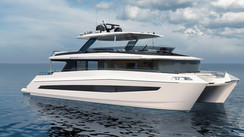
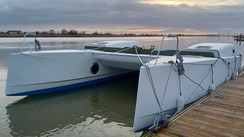
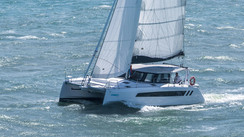
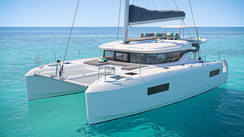
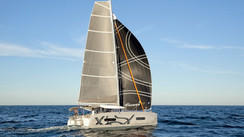
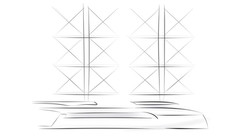
What readers think
Post a comment
No comments to show.